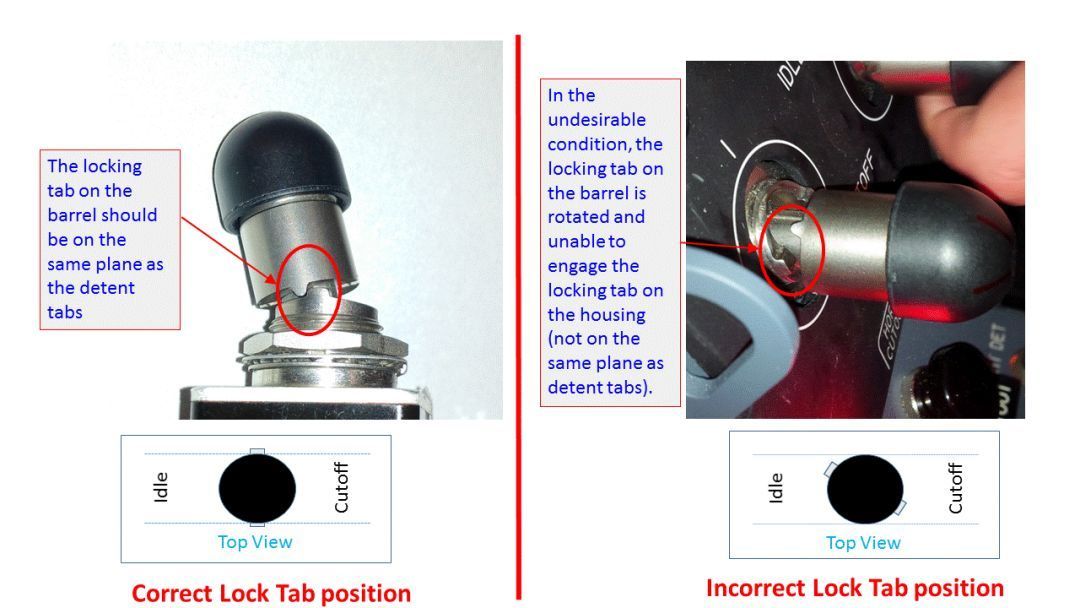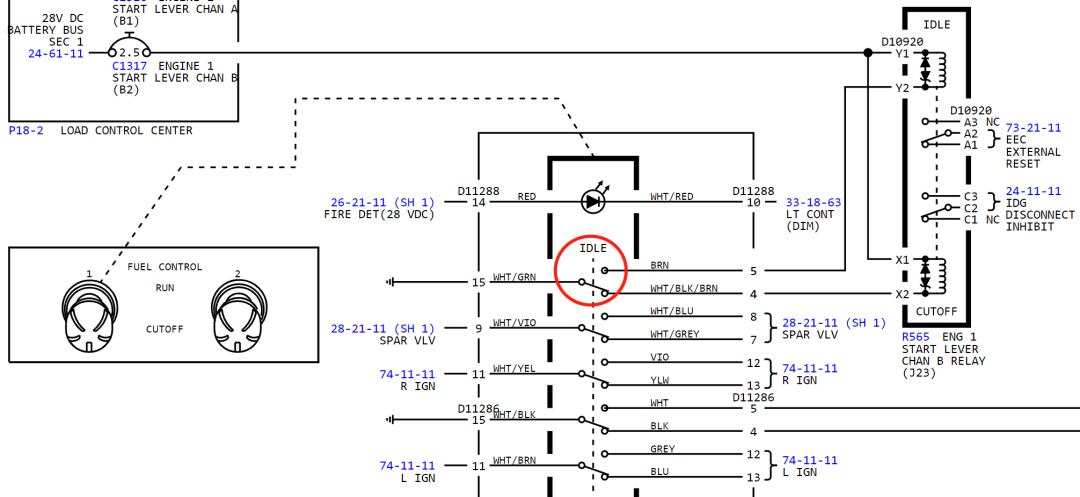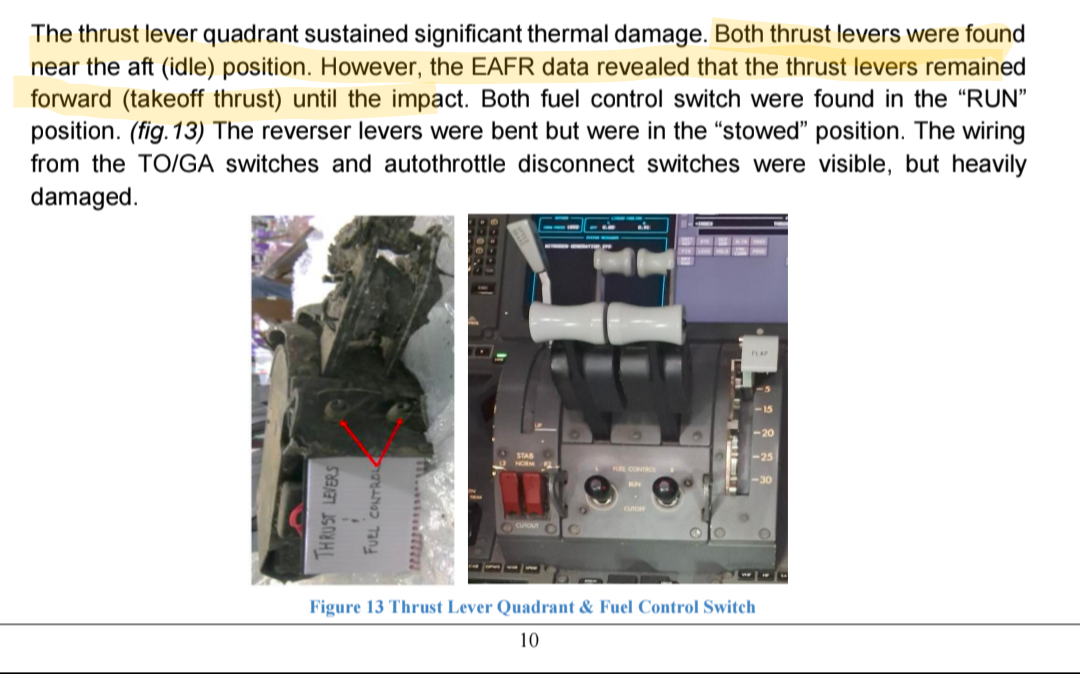July 12, 2025, 08:42:00 GMT
permalink Post: 11920296
08:07:33 ATC: Takeoff clearance
08:07:37 A-SMGCS: Aircraft starts rolling
08:08:33 EAFR: V1 153kts
08:08:35 EAFR: Vr 155kts
08:08:39 EAFR: Gnd-Air mode transition
08:08:42 EAFR: Max IAS 180kts, Eng 1/2 Cutoff switches activate within 1 second of each other
08:08:42 CVR: "Why did you cut off", "I did not" (exact time not specified)
08:08:42 A-SMGCS: RAT deployed (exact time not specified)
08:08:47 EAFR: Both engine N2 below min idle. RAT hyd pwr commences
08:08:52 EAFR: Eng 1 cutoff to RUN
08:08:54 EAFR: APU inlet door opens (auto start logic)
08:08:56 EAFR: Eng 2 cutoff to RUN
08:09:05 ATC: Mayday call
08:09:11 EAFR recording stops
Fuel cutoff switches operated within 1 second of each other suggests to me that the locking mechanism wasn't working as per (SAIB) No. NM-18-33. Any loose item could have accidentally (or not) operated the switches (including hands).
Last edited by sorvad; 12th July 2025 at 09:03 . Reason: Clarification
Subjects
APU
CVR
EAFR
Fuel (All)
Fuel Cutoff
Fuel Cutoff Switches
MAYDAY
Pilot "Why did you cut off"
Preliminary Report
RAT (All)
RAT (Deployment)
RUN/CUTOFF
SAIB NM-18-33
Special Airworthiness Information Bulletin
Timeline (Preliminary Report)
V1
Links are to this post in the relevant subject page so that this post can be seen in context.
Reply to this quoting this original post. You need to be logged in. Not available on closed threads.
July 12, 2025, 08:55:00 GMT
permalink Post: 11920310
On the 787-8, as all modern planes, switches are not cabled as dry closing contacts all the way from the switch poles to the affected end devices (FADECs in the case of fuel cutoff switches), but rather connect locally to an analogue/digital converter to encode the switch position data onto the digital comms bus ARINC629 which allows all aircraft systems to talk to one another.
Are the fuel cutoff switches, which are positioned adjacent to the stab trim switches, connected to the same ADC module which produced the error message on the previous flight, which maintenance was unable to resolve before the accident flight took off? I do not know, but it must be worthy of being looked into.
Subjects
Fuel (All)
Fuel Cutoff
Fuel Cutoff Switches
Preliminary Report
Links are to this post in the relevant subject page so that this post can be seen in context.
Reply to this quoting this original post. You need to be logged in. Not available on closed threads.
July 12, 2025, 09:18:00 GMT
permalink Post: 11920332
Subjects
Fuel (All)
Fuel Cutoff
Fuel Cutoff Switches
Fuel Cutoff Switches (detent)
Links are to this post in the relevant subject page so that this post can be seen in context.
Reply to this quoting this original post. You need to be logged in. Not available on closed threads.
July 12, 2025, 09:26:00 GMT
permalink Post: 11920339
Subjects
Fuel (All)
Fuel Cutoff
Fuel Cutoff Switches
Fuel Cutoff Switches (detent)
Links are to this post in the relevant subject page so that this post can be seen in context.
Reply to this quoting this original post. You need to be logged in. Not available on closed threads.
July 12, 2025, 09:37:00 GMT
permalink Post: 11920352
Subjects
Fuel (All)
Fuel Cutoff
Fuel Cutoff Switches
Fuel Cutoff Switches (detent)
Links are to this post in the relevant subject page so that this post can be seen in context.
Reply to this quoting this original post. You need to be logged in. Not available on closed threads.
July 12, 2025, 09:56:00 GMT
permalink Post: 11920377
The report says,
It suggests to me that the RAT deployment was initiated while the engines were still above idle and generating electrical power. Obviously one of the pilots could have done it via depressing the switch, as it's a "dual engine failure/stall" memory item (see Air India Ahmedabad accident 12th June 2025 Part 2 ) that won't hurt anything.
Is there a way for the RAT to deploy while the engines are still above idle?
Subjects
EAFR
Fuel (All)
Fuel Cutoff
Fuel Cutoff Switches
Hydraulic Failure (All)
RAT (All)
RAT (Deployment)
Links are to this post in the relevant subject page so that this post can be seen in context.
Reply to this quoting this original post. You need to be logged in. Not available on closed threads.
July 12, 2025, 10:14:00 GMT
permalink Post: 11920399
Last edited by Senior Pilot; 12th July 2025 at 10:25 . Reason: Quote
Subjects
FAA
Fuel (All)
Fuel Cutoff
Fuel Cutoff Switches
SAIB NM-18-33
Links are to this post in the relevant subject page so that this post can be seen in context.
Reply to this quoting this original post. You need to be logged in. Not available on closed threads.
July 12, 2025, 10:33:00 GMT
permalink Post: 11920418
And while I was painfully crawling the thread, I noticed the following picture about an "undesirable condition":

Incorrect lock tab position on fuel cut-off switch
If this incorrect mounting is actually possible, it would possibly remain unnoticed from the pilots (normal "pull-up then move" action is unaffected), but it would cancel the protective function of the so-called "locking tab", and even limit the travel of the switch handle in both directions, making it more vulnerable to an undesired change of state.
The photos above seem convincing enough, but I'd be very grateful for an informed opinion on this assembly mistake. Even if this is possible, the probability of both switches being unexpectedly snapped seems very remote to say the least, but not as remote as previously estimated.
Subjects
Fuel (All)
Fuel Cutoff
Fuel Cutoff Switches
SAIB NM-18-33
Special Airworthiness Information Bulletin
Links are to this post in the relevant subject page so that this post can be seen in context.
Reply to this quoting this original post. You need to be logged in. Not available on closed threads.
July 12, 2025, 10:37:00 GMT
permalink Post: 11920429
revealed that the throttle control module was replaced on VT-ANB in 2019 and 2023.
However, the reason for the replacement was not linked to the fuel control switch. There has
been no defect reported pertaining to the fuel control switch since 2023 on VT-ANB.
Subjects
Fuel (All)
Fuel Cutoff
Fuel Cutoff Switches
Links are to this post in the relevant subject page so that this post can be seen in context.
Reply to this quoting this original post. You need to be logged in. Not available on closed threads.
July 12, 2025, 11:26:00 GMT
permalink Post: 11920464
I could hardly figure what the "disengaged" word meant in this context, so I did a Google search for the switch part numbers (especially "766AT614-3D") to figure the difference between them, and a page from this chinese web site was part of the results.
And while I was painfully crawling the thread, I noticed the following picture about an "undesirable condition":

Incorrect lock tab position on fuel cut-off switch
If this incorrect mounting is actually possible, it would possibly remain unnoticed from the pilots (normal "pull-up then move" action is unaffected), but it would cancel the protective function of the so-called "locking tab", and even limit the travel of the switch handle in both directions, making it more vulnerable to an undesired change of state.
The photos above seem convincing enough, but I'd be very grateful for an informed opinion on this assembly mistake. Even if this is possible, the probability of both switches being unexpectedly snapped seems very remote to say the least, but not as remote as previously estimated.
One other useful thing from that web site is a partial schematic which shows the connection of the 4 poles in the switch. I believe this is from a 737NG but it should be the same idea.

Subjects
Fuel (All)
Fuel Cutoff
Fuel Cutoff Switches
Honeywell
SAIB NM-18-33
Special Airworthiness Information Bulletin
Links are to this post in the relevant subject page so that this post can be seen in context.
Reply to this quoting this original post. You need to be logged in. Not available on closed threads.
July 12, 2025, 11:43:00 GMT
permalink Post: 11920474
Previously I had assumed that the ADS-B data cut out at the same time as power was lost, so I imagined that whatever caused the fairly clear loss of thrust would have happened not too long before. But this report throws a bit of a wrench in my understanding of that.
According to the report, the fuel cutoff switches transition from RUN to CUTOFF at or very shortly after 08:08:42 UTC. Both engines' N2 values pass below minimum idle speed and the RAT begins supplying hydraulic power at about 08:08:47. Does this not imply that the generators have already been lost? With the APU also being off (the APU inlet door is noted to start opening at 08:08:54), I would have expected ADS-B data to cut out at or before 08:08:47. But curiously FlightRadar24 at least claims to have received data frames from the aircraft until 08:08:51.640970, almost five seconds later and almost ten seconds after the transition to CUTOFF (though the last frame containing coordinates comes at 08:08:50.871005).
Could anyone with relevant experience confirm how long it would take for AC power to be lost in this situation? Also, is it usual/unusual for a preliminary report like this to mention if/when the flight recorder switched to its independent power supply? I imagine it would definitely be in the final report, but I'd hoped it would be easily observable enough to be in this one.
Beyond idle curiosity I'm asking because the report also says the no. 1 engine's cutoff switch transitioned from CUTOFF to RUN at "about 08:08:52", which oddly coincides with the last ADS-B data frame at 08:08:51.640970, and that seems important somehow. Or more likely I'm just ignorant of some quirk of the 787's electrical system.
For reference FR24's CSV containing all ADS-B frames supposedly received from the aircraft can be found in their post here: https://www.flightradar24.com/blog/f...rom-ahmedabad/
Subjects
ADSB
APU
DFDR
FlightRadar24
Fuel (All)
Fuel Cutoff
Fuel Cutoff Switches
Generators/Alternators
Hydraulic Failure (All)
Preliminary Report
RAT (All)
RUN/CUTOFF
Timeline (Preliminary Report)
Links are to this post in the relevant subject page so that this post can be seen in context.
Reply to this quoting this original post. You need to be logged in. Not available on closed threads.
July 12, 2025, 11:51:00 GMT
permalink Post: 11920482
Subjects
Fuel (All)
Fuel Cutoff
Fuel Cutoff Switches
Preliminary Report
RUN/CUTOFF
Timeline (Preliminary Report)
Links are to this post in the relevant subject page so that this post can be seen in context.
Reply to this quoting this original post. You need to be logged in. Not available on closed threads.
July 12, 2025, 12:02:00 GMT
permalink Post: 11920495
On the 787-8, as all modern planes, switches are not cabled as dry closing contacts all the way from the switch poles to the affected end devices (FADECs in the case of fuel cutoff switches), but rather connect locally to an analogue/digital converter to encode the switch position data onto the digital comms bus ARINC629 which allows all aircraft systems to talk to one another.
Are the fuel cutoff switches, which are positioned adjacent to the stab trim switches, connected to the same ADC module which produced the error message on the previous flight, which maintenance was unable to resolve before the accident flight took off? I do not know, but it must be worthy of being looked into.
I think they're called remote data concentrators - in many cases it is a conversion from a direct digital input to a bus signal; electronics would not call it an 'analog' input unless it was actually measuring a quantitative value.
The report says,
As per the EAFR data both engines N2 values passed below minimum idle speed, and the RAT hydraulic pump began supplying hydraulic power at about 08:08:47 UTC.
This was 5 seconds after the fuel was cut off.
It suggests to me that the RAT deployment was initiated while the engines were still above idle and generating electrical power. Obviously one of the pilots could have done it via depressing the switch, as it's a "dual engine failure/stall" memory item (see Air India Ahmedabad accident 12th June 2025 Part 2 ) that won't hurt anything.
Is there a way for the RAT to deploy while the engines are still above idle?
That is a very good question IMHO.
Subjects
EAFR
Fuel (All)
Fuel Cutoff
Fuel Cutoff Switches
Generators/Alternators
Hydraulic Failure (All)
Preliminary Report
RAT (All)
RAT (Deployment)
Links are to this post in the relevant subject page so that this post can be seen in context.
Reply to this quoting this original post. You need to be logged in. Not available on closed threads.
July 12, 2025, 12:09:00 GMT
permalink Post: 11920505
It doesn\x92t explain the reason behind going for the stab cut out switches when the report makes no mention of any stab warning - which surely would be a highly Important event given the closeness of the switches.
Subjects
Fuel (All)
Fuel Cutoff
Fuel Cutoff Switches
Muscle Memory
Links are to this post in the relevant subject page so that this post can be seen in context.
Reply to this quoting this original post. You need to be logged in. Not available on closed threads.
July 12, 2025, 12:32:00 GMT
permalink Post: 11920533
Mods, if you don't lock the thread, I'm going back to Facebook!

Subjects
Action slip
Engine Failure (All)
Engine Shutdown
Fuel (All)
Fuel Cutoff
Fuel Cutoff Switches
Thread Moderation
Links are to this post in the relevant subject page so that this post can be seen in context.
Reply to this quoting this original post. You need to be logged in. Not available on closed threads.
July 12, 2025, 12:46:00 GMT
permalink Post: 11920554
The report says,
It suggests to me that the RAT deployment was initiated while the engines were still above idle and generating electrical power. Obviously one of the pilots could have done it via depressing the switch, as it's a "dual engine failure/stall" memory item (see Air India Ahmedabad accident 12th June 2025 Part 2 ) that won't hurt anything.
Is there a way for the RAT to deploy while the engines are still above idle?
Subjects
EAFR
Fuel (All)
Fuel Cutoff
Fuel Cutoff Switches
Hydraulic Failure (All)
RAT (All)
RAT (Deployment)
Links are to this post in the relevant subject page so that this post can be seen in context.
Reply to this quoting this original post. You need to be logged in. Not available on closed threads.
July 12, 2025, 12:49:00 GMT
permalink Post: 11920556

Relevant section in the preliminary report
Subjects
EAFR
Fuel (All)
Fuel Cutoff
Fuel Cutoff Switches
Preliminary Report
Links are to this post in the relevant subject page so that this post can be seen in context.
Reply to this quoting this original post. You need to be logged in. Not available on closed threads.
July 12, 2025, 13:04:00 GMT
permalink Post: 11920568
All we know is the fuel cut off switches were flipped to Cutoff for 10 seconds and then to run again. Not how or by what. The focus should be on how this could occur. Accidentally, technical malfunction, a foreign object somehow hitting and moving them or other reason?
Theories needs to be tested in a cockpit with the exact configuration of this aircraft and with the angles and forces involved as much as we can. It should be possible to simulate it pretty closely and whatever happened should be repeatable. It's going to be something extremely unlikely, or we'd have seen it before in 10 years of 787 service.
Subjects
Fuel (All)
Fuel Cutoff
Fuel Cutoff Switches
Links are to this post in the relevant subject page so that this post can be seen in context.
Reply to this quoting this original post. You need to be logged in. Not available on closed threads.
July 12, 2025, 13:14:00 GMT
permalink Post: 11920575
All we know is the fuel cut off switches were flipped to Cutoff for 10 seconds and then to run again. Not how or by what. The focus should be on how this could occur. Accidentally, technical malfunction, a foreign object somehow hitting and moving them or other reason?
Theories needs to be tested in a cockpit with the exact configuration of this aircraft and with the angles and forces involved as much as we can. It should be possible to simulate it pretty closely and whatever happened should be repeatable. It's going to be something extremely unlikely, or we'd have seen it before in 10 years of 787 service.
He didn\x92t say, \x93did you just see that pink elephant fall off the dashboard?\x94
How are you going to \x93simulate something pretty closely\x94 when it\x92s also \x93extremely unlikely\x94?
The chance that it was a mechanical or electrical failure of both fuel switches , 2 seconds apart , is for all intents and purposes, zero.
Therefore they were moved by hand.
Subjects
Electrical Failure
Fuel (All)
Fuel Cutoff
Fuel Cutoff Switches
Links are to this post in the relevant subject page so that this post can be seen in context.
Reply to this quoting this original post. You need to be logged in. Not available on closed threads.
July 12, 2025, 13:47:00 GMT
permalink Post: 11920592
All we know is the fuel cut off switches were flipped to Cutoff for 10 seconds and then to run again. Not how or by what. The focus should be on how this could occur. Accidentally, technical malfunction, a foreign object somehow hitting and moving them or other reason?.
Subjects
Fuel (All)
Fuel Cutoff
Fuel Cutoff Switches
Links are to this post in the relevant subject page so that this post can be seen in context.
Reply to this quoting this original post. You need to be logged in. Not available on closed threads.